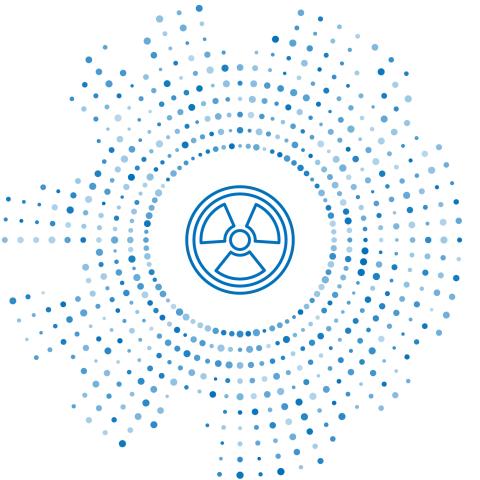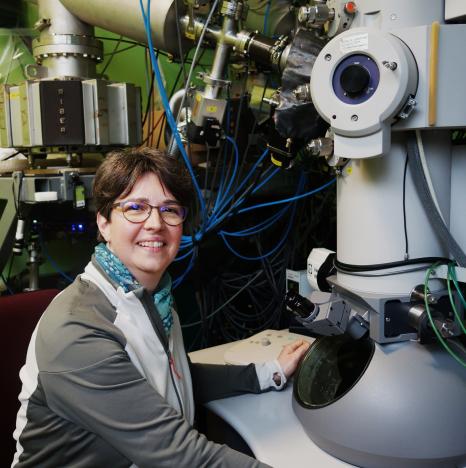
Aurélie Gentils: Optimising materials with nuclear applications
Aurélie Gentils is a physical chemist, CNRS research fellow at the Laboratory of the Physics of the two Infinities - Irène Joliot-Curie (IJCLab - Univ. Paris-Saclay, National Centre for Scientific Research CNRS, Univ. Paris Cité). Specialised in materials science, she conducts research on the mechanisms of resistance to irradiation of materials with nuclear applications. Together with her team, she successfully produced an oxide dispersion-strengthened steel, using ions, for the first time.
Aurélie Gentils is in charge of one of the two teams of the IJCLab's Energy and Environment Pole. Around ten researchers make up the CHIMENE team (Chemistry, Irradiation, Materials, Modelling, and Electrochemistry for Nuclear and Environment), the key words that characterise its research. "What they have in common is the study of materials subjected to effects such as corrosion or irradiation, with a lot of experimental work and a fair bit of modelling," the researcher explains.
Irradiate in order to understand
With her colleagues in the "Materials and Irradiation" research topic at IJCLab, Aurélie Gentils uses ion beams fired by particle accelerators to modify, characterise or synthesise materials with nuclear applications. The goal? To study future fuels and materials for structures that can be used for both current and future nuclear systems: 3rd and 4th generation nuclear fission reactors, or nuclear fusion (ITER), small modular reactors (SMR), or nuclear waste conditioning matrices. "We subject these materials to different levels of radiation and temperatures to experimentally simulate their conditions of use," explains the researcher. To this end, Aurélie Gentils uses model materials, which are free from impurities. "We form hypotheses with respect to the real material that allow us to understand the fundamental mechanisms of how these particle radiations interact with the constituents of the material." The ion beams are also used to characterise the material, i.e. to identify traces of its chemical evolution and its damage according to the depth. These two areas of research are supported by several programmes, including the Nuclear: Energy, Environment, Waste, Society (NEEDS) programme of the CNRS's National Institute of Nuclear and Particle Physics (IN2P3) and the French Research Federation for Magnetic Confinement Fusion - ITER.
A unique synthesis in the world
"To improve the mechanical properties of steels, we use a dispersion of nanoprecipitates," Aurélie Gentils explains. During exchanges with other scientists who had come to test the irradiation properties of oxide dispersion-strengthened steels, the researcher had the idea of using ion beams to intentionally incorporate elements into the steel (yttrium, titanium, oxygen) which agglomerate after heat treatment. "We are the first to have used ion beams to synthesise metal nano-oxides in a ferritic matrix, thereby de-correlating different parameters which influence their formation." This synthesis opens up new avenues for research, conducted in collaboration with the Centre for Nanoscience and Nanotechnology (C2N - Univ. Paris-Saclay, CNRS, Univ. Paris Cité) and the 'Institut matériaux microélectronique nanosciences de Provence' (Institute of Microelectronics and Nanosciences in Provence or IM2NP), based in Marseille. "We still have a long way to go before we achieve the ideal material, but early studies have demonstrated the same properties as in conventional production." Ultimately, the goal will be to optimise the industrial production of these materials, not only those with nuclear applications. "Our studies on irradiated materials (size and density of flaws, evolution of the elemental composition, etc.) can be applied to any field where the material is subjected to radiation (geology, space, etc)."
The Mosaic platform
This research would not have been possible without the team from the Mosaic research platform at the laboratory. Mosaic brings together various pieces of equipment, including the two accelerators ARAMIS and IRMA, linked together in the JANNuS-Orsay experimental hall and connected to a transmission electron microscope. The diversity of the accelerated ions makes this device unique in the world. The platform also comprises the SIDONIE isotope separator, the Andromeda accelerator, and soon an implanter (a lower energy accelerator) from the Institute of Physics of the 2 Infinities (IP2I) in Lyon. "We recently secured funding to build a new beamline for our ion accelerator, to which we will attach an X-ray diffractometer, another characterisation technique, to obtain additional information about our materials."
These special attributes mean that the platform has unique expertise in Europe, which can be deployed for scientific projects in a variety of fields. "Depending on the objective, we can guide our accelerated ions through the different beamlines and directly into the microscope," Aurélie Gentils explains, who is also the platform's scientific manager. “We welcome scientists from all over the world according to the roadmap provided by the international committee of EMIR&A, a national research infrastructure that brings together ion and electron accelerators." The laboratory teams use 40% of the beam time and the rest is divided between practical work, academics and industrial companies.
Sharing science
At secondary school, the young Aurélie Gentils first took an interest in biology, before branching out into physics and chemistry during a first general orientation semester at Université Paris-Sud (now Université Paris-Saclay). The trigger to enter research was a master's internship (master 1) at a university laboratory which specialised in hydrogen embrittlement of materials, in particular materials used in nuclear reactors. "To each of my questions, a manager from EDF replied: 'We don't know, we need to find out!’ That's what I ended up doing!" After her DEA (2nd-year Master's) in 2000, she defended her thesis in 2003 on the experimental simulation of the effects of fission products at the Centre for Nuclear and Material Sciences (CSNSM, one of the five laboratories which merged into IJCLab). She then went on to do a post-doctoral fellowship at the University of Glasgow, Scotland, where she developed additional expertise in electron microscopy. Having returned to France in 2005, she was recruited as a CNRS research fellow at the Centre for ionisation studies and research (CERI, now Extreme Conditions and Materials: High Temperature and Irradiation or CEMHTI laboratory) in Orleans, where she stayed for three years. She returned to the CSNSM at the end of 2008.
Aurélie Gentils is clearly engaged for the younger generation, whether by supervising interns and PhD candidates (she obtained her Accreditation to Supervise Research - HDR in French - in 2017), by taking part in career days at her former secondary school in Montereau Fault-Yonne, or by opening the doors of her laboratory to schoolchildren during the 'Fête de la Science' (Science Festival). "Getting kids excited about science, and girls in particular, is an integral part of our profession." The message is clear: "Believe in yourself and go for it!" At Université Paris-Saclay? "Of course! Its combination of engineering schools and universities is unique. The more different profiles work together, the better for science!"

